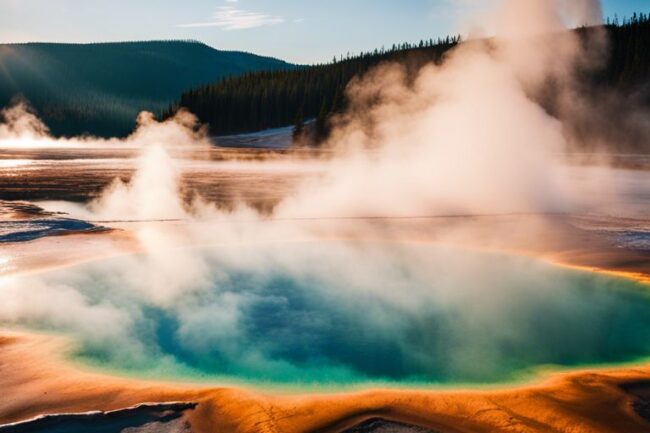You, the lover of all things wild and majestic, will be in awe of the incredible beauty and natural wonders that await you at Yellowstone National Park in Wyoming. From geysers and hot springs to grizzly bears and bison roaming free, this iconic park is a true testament to the power and beauty of Mother Nature. Embark on a journey through this incredible landscape and let the wonders of Yellowstone leave you breathless and inspired.
Key Takeaways:
- Yellowstone National Park: America’s first national park, located in Wyoming, is a natural wonder known for its geothermal features, wildlife, and breathtaking landscapes.
- Geothermal Wonders: Yellowstone boasts famous geothermal features like Old Faithful geyser, Grand Prismatic Spring, and geothermal pools, showcasing the power and beauty of nature’s forces.
- Biodiversity: The park is home to a wide range of wildlife, including bison, elk, bears, wolves, and more, making it a paradise for nature enthusiasts and wildlife lovers.
Geology and Landscapes
Formation of Yellowstone’s Unique Geology
Yellowstone’s geology is a testament to the power and beauty of nature. The park sits atop a supervolcano, with geothermal features like hot springs, geysers, and mud pots dotting the landscape. These features are a result of ongoing volcanic activity beneath the surface, creating a landscape that is constantly changing and evolving. To learn more about the fascinating natural wonders of Yellowstone, check out 10 Best natural wonders at Yellowstone National Park.
Exploring the Park’s Diverse Landscapes
For visitors to Yellowstone National Park, the diverse landscapes offer a range of adventures and experiences. From the iconic geysers of the Upper Geyser Basin to the dramatic canyons of the Grand Canyon of the Yellowstone, there is something for everyone to enjoy. For instance, the park’s meadows are home to abundant wildlife, including bison, elk, and bears, making it a paradise for nature lovers and outdoor enthusiasts alike.
Wildlife and Ecosystems
The Majesty of Yellowstone’s Large Mammals
To witness the grandeur of Yellowstone’s large mammals is to witness nature’s true magnificence. The park is home to iconic species such as bison, elk, moose, and grizzly bears. These majestic creatures roam freely across vast stretches of untouched wilderness, captivating visitors with their grace and power.
The Importance of Smaller Creatures and Microorganisms
Wildlife in Yellowstone extends far beyond its large mammals. The park’s ecosystem thrives on the intricate relationships between smaller creatures and microorganisms. From tiny insects to microscopic bacteria, these often-overlooked beings play vital roles in maintaining the delicate balance of the park’s environment.
Human History and Exploration
The Native American Legacy in Yellowstone
Not only is Yellowstone National Park a geological wonder, but it also holds a rich cultural history. The Native American tribes, such as the Shoshone, Bannock, Blackfeet, Crow, and Nez Perce, have long-standing connections to the land within the park’s boundaries.
Early European Exploration and Settlement
Native totemic figures and petroglyphs in Yellowstone speak of early human presence in the area. European explorers like John Colter in the early 19th century were some of the first outsiders to document their encounters with this wild landscape.
For instance, the Lewis and Clark Expedition of 1804-1806 made note of geothermal features that hinted at the volcanic activity underlying the region. However, it wasn’t until the late 1860s that the first formal expeditions to explore Yellowstone were launched.
Conservation Efforts and Tourism
Many 10 Wonders of Yellowstone showcase the park’s remarkable beauty and ecological significance, attracting millions of tourists annually. Yellowstone National Park’s conservation efforts are crucial in preserving its pristine wilderness for future generations while balancing the impact of tourism.
Preserving Yellowstone’s Natural Resources
Resources within Yellowstone, such as geothermal features and wildlife habitats, are carefully managed to maintain the park’s natural balance. Conservation efforts focus on protecting biodiversity and ecosystems to ensure the long-term sustainability of the park’s unique environment.
Responsible Tourism and Visitor Etiquette
Efforts to promote responsible tourism and visitor etiquette are important for preserving Yellowstone’s fragile ecosystem. Visitors are encouraged to stay on designated trails, respect wildlife from a safe distance, and dispose of waste properly to minimize their impact on the environment.
Etiquette plays a significant role in minimizing human disturbance and maintaining the park’s natural beauty. By following guidelines and showing respect for nature, visitors can contribute to the conservation of Yellowstone’s incredible natural wonders.
Summing up
Taking this into account, Yellowstone National Park in Wyoming truly stands as America’s Natural Wonder, with its majestic geysers, diverse wildlife, and stunning landscapes. It is a place where nature’s beauty and power are on full display, captivating visitors and inspiring awe and appreciation for the natural world. A testament to the importance of conservation and preservation, Yellowstone remains a national treasure and a must-visit destination for all lovers of the great outdoors.
FAQ
Q: What is Yellowstone National Park?
A: Yellowstone National Park is a renowned national park located primarily in the U.S. state of Wyoming, although it also extends into Montana and Idaho. It is widely considered one of America’s most treasured natural wonders.
Q: What makes Yellowstone National Park so special?
A: Yellowstone is known for its geothermal features, including Old Faithful geyser, colorful hot springs, bubbling mud pots, and fumaroles. It also boasts a diverse range of wildlife, including grizzly bears, wolves, bison, and elk.
Q: When was Yellowstone National Park established?
A: Yellowstone National Park was established on March 1, 1872, making it the first national park in the world. This designation marked a significant milestone in the conservation movement.
Q: What activities can visitors enjoy at Yellowstone National Park?
A: Visitors to Yellowstone can partake in a variety of activities, such as hiking, camping, wildlife watching, fishing, and ranger-led programs. The park offers something for outdoor enthusiasts of all ages and interests.
Q: How can I best experience the beauty of Yellowstone National Park?
A: To truly experience the beauty of Yellowstone, consider exploring the park’s diverse ecosystems, including its geothermal features, forests, canyons, and rivers. Be sure to take your time, immerse yourself in nature, and tread lightly on this precious land.

